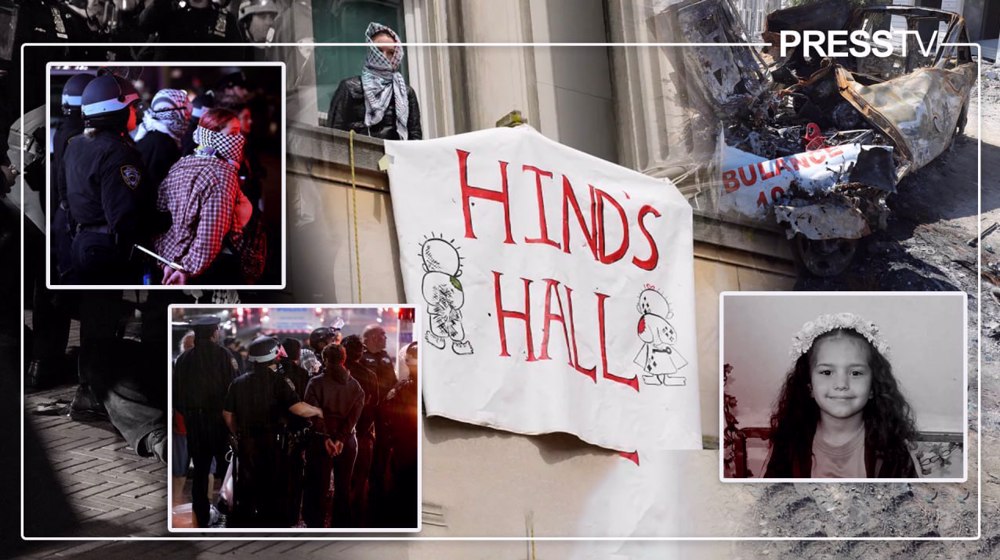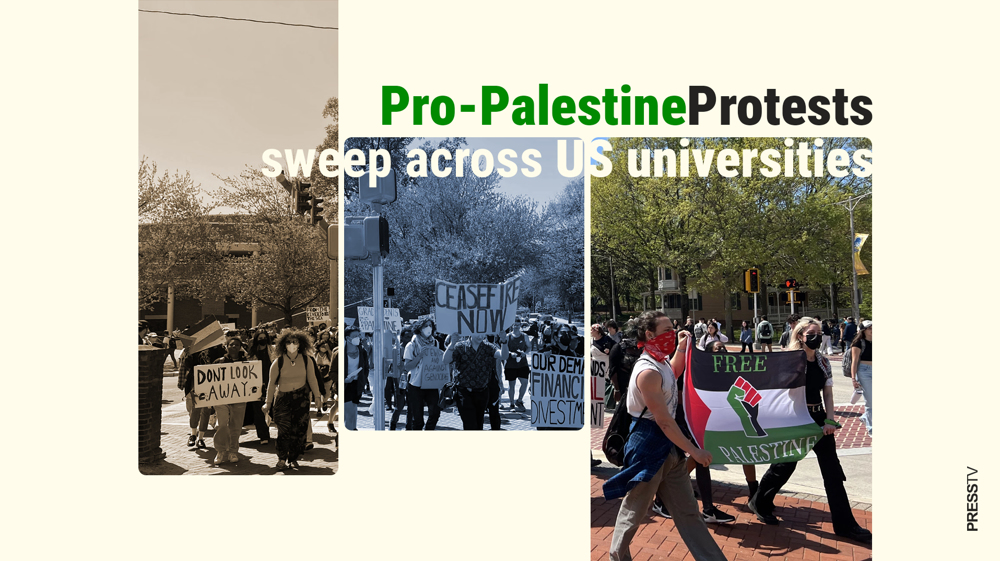Explainer: What’s significance of Columbia’s Hamilton Hall, renamed ‘Hind’s Hall’?
By Press TV Website Staff
In the wee hours of Tuesday morning, student protesters at Columbia University in New York broke into Hamilton Hall on campus and renamed it “Hind’s Hall” in honor of the 6-year-old Palestinian girl Hind Rajab who was killed by the Israeli regime forces in Gaza.
Hamilton Hall, rechristened as “Hind’s Hall”, has traditionally been known as a venue for protests at Columbia University since the famous 1985 protests.
Angry protesters, who have been calling for the university’s divestment from firms that aid and abet the Israeli genocidal campaign in the Gaza Strip, carried barricades and gate-crashed into the iconic hall while many others formed a human chain outside the entrance.
At around 1:40 am local time, a group of protesting students raised a banner reading “Hind’s Hall”, named after the Palestinian girl who went missing in Gaza and was eventually declared dead, killed in cold blood by the trigger-happy Israeli regime soldiers.
The student action came two weeks after Columbia University president Minouche Shafik in a controversial move invited the New York police to violently break the “Gaza Solidarity Encampment” on April 18, which was followed by the arrest of more than 100 students.
Who was Hind Rajab?
Hind Rajab was a six-year-old Palestinian girl from Gaza who was killed by the Israeli military on January 29, after being the sole survivor of Israeli tank fire which killed her aunt, uncle, and four cousins.
She became an enduring symbol of the horrors of the genocidal war against Gaza after her emergency call with the Palestinian Red Crescent Society (PRCS) was released.
In the audio recordings, the frightened girl was heard beseeching for help, telling the dispatcher: "I'm so scared, please come. Come take me. Please, will you come?"
This tragedy unfolded on January 29 when Bashar Hamada, Hind’s maternal uncle, decided to escape the brutal bombardment of the occupying Israeli regime.
On his way to a place designated “safe”, he was stopped by the Israeli army in the Tal Al-Hawa neighborhood in the south of the besieged strip.
Hind’s status was unknown till February 10, when her family reported that she was found dead in the ravaged vehicle along with some of her family members in Gaza.
“Hind and everyone else in the car is martyred,” her grandfather Hamada announced.
Gaza's health ministry also announced that she was murdered by the regime forces.
“She was killed by [Israeli] occupation forces with all those who were with her in the car outside the petrol station in Tel al-Hawa,” the ministry said in a statement at the time.
What is Hamilton Hall?
Hamilton Hall is an academic building on the Morningside Heights campus in Manhattan, New York City, serving as the administrative office of Columbia College, the oldest undergraduate college of Columbia University.
The building is named after Alexander Hamilton, one of the American founding fathers and a leader in the abolition of the slave trade during the presidency of George Washington.
Hamilton Hall has great historical significance for student activism at Columbia University, particularly in the context of racial equality, and has been occupied and symbolically renamed several times.
During the protests of April 1968 against the Vietnam War, a multiracial group barricaded themselves inside the hall, renaming it "Malcolm X Liberation College."
The renaming was a response to reports about Columbia's plans to build a gymnasium in nearby Harlem that student activists claimed would effectively be racially segregated.
After a week of occupation, police violently intervened and engaged in clashes with protesting students dragging them outside, injuring many and arresting hundreds.
Four years later, anti-war students occupied the hall again for a week, using furniture to barricade the entrance, and this time they handed over the building to the police without violence or arrests.
In 1985, students blockaded the hall for three weeks and renamed it "Nelson Mandela Hall," demanding that the university divest from South African apartheid.
What is the significance of Columbia University?
The occupation of Hamilton Hall has symbolic value because all the aforementioned protests prophetically announced the successful abolition of racial segregation, the end of the Vietnam War and the dissolution of South African apartheid.
It also has significance because Columbia University is where the pro-Israel lobby has recorded a series of defeats in its attempts to expel and smear American-Palestinian professors, including Joseph Massad, Rashid Khalidi, Edward Said and Nadia Abu El-Haj.
Joseph Massad was tried to be expelled with a slander film accusing him of "anti-Semitism", but an ad hoc university committee concluded after an investigation that the accusations were unfounded.
Because of their open support for Palestinian independence, emails of Massad and Said were spammed by Zionist activists with hundreds of offensive and threatening messages.
Later, pro-Israel activists also unsuccessfully tried to deny tenure to anthropology professor Nadia Abu El-Haj, just because in one of her books she challenged the religious manipulation of archaeology in favor of the Zionist ideology.
The university has been at the center of protests against the Israeli genocide the past few weeks, with students refusing to retreat or surrender despite heavy-handed police action.
As of Wednesday, the police remained on the campus, and nearly 300 students were taken into custody from the university campus after they took over Hamilton Hall.
Over the past two weeks, more than 1,000 students have been arrested on various university campuses across the US for demanding an end to the Israeli genocide in Gaza.
More than 34,500 Palestinians have been killed in the besieged Palestinian territory since October last year, 70 percent of them children and women.
Iran warns US against resumption of ‘maximum pressure’ policy
Israeli strikes kill 28 people in Lebanon
Hezbollah strikes major Israeli air force base for first time
Iran authorizes imports and sale of unleaded gasoline at free prices
Who said what about genocide in Gaza and Lebanon at OIC-Arab League summit?
More journalists killed by Israel in Gaza than in any conflict in recent decades: Report
Israeli attacks on Syria serious threat to regional stability: Iranian diplomat
Yemen carries out pre-emptive strike against US aircraft carrier













 This makes it easy to access the Press TV website
This makes it easy to access the Press TV website